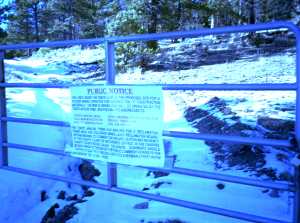Essay by Paul Larmer
Wildlife – May 2002 – Colorado Central Magazine
CRIMSON SPLOTCHES, like drips from a painter’s brush, pock the snow and lichen-covered rocks. A few steps farther, they intermingle with patches of gray-brown hair, some of which cling to the stiff branches of sagebrush. Then more blood, more hair, more blood, on down the hill.
And finally, the body. Or what’s left of it.
The partially furred skull grins blindly up at me, its eye sockets picked clean by magpies and ravens, no doubt. The torso is also gone, save for the rib cage, curved and hollow as a wine barrel. Only the hooves look anything like the living mule deer that made its last stand in this draw.
That probably happened a couple of nights ago. My wife came in from feeding the horses and mentioned the ecstatic cackling of coyotes over the ridge.
Winter is a brutal season for wild ungulates. While many mammals head underground for a nap, they clump together in herds, hoping the fat they gained in the summer and autumn can outlast sub-freezing temperatures, a diminishing food supply and the ever-lurking predators.
Still, it’s hard to drum up much sympathy for this particular animal. He was just one of hundreds I see every night browsing like domestic sheep on hay fields. It seems only right that the magpies and coyotes get one once in a while, for winter is equally tough on them.
Not all Westerners view it that way. A few years ago, when mule deer numbers were down in several states, a small but vocal group of hunters began a campaign against coyotes, claiming they took more than their share of deer, especially vulnerable fawns. A former neighbor held that view.
“I shoot them whenever I can,” Rich said. “They just wipe out the herds.”
Hunters like Rich have pushed state wildlife departments in Idaho and Colorado to aggressively pursue coyote extermination. But the departments, buffeted by environmentalists and animal rights activists on the other side, have resisted extermination campaigns, focusing instead on science.
The results of their studies on fawn survival are now in and the picture they reveal is complicated. While coyotes do kill fawns on occasion, they play a minor role in the overall size and health of deer herds. The major deer killer, aside from weather, is poor habitat, says Tom Pojar, who is starting a fourth year of mule-deer research for the Colorado Division of Wildlife.
Last year, Pojar’s researchers found that 14 percent of the dead fawns they tracked died of sickness and malnutrition, sure signs that the land is not providing the way it should.
Up on the public lands, the problem is decades of fire suppression and overgrazing, which have created an aging, brushy ecosystem lacking the mix of forbs, grasses and healthy sagebrush that deer need to survive winters. On the lower-elevation private lands, where many deer and elk spend the winter, prime winter habitat is getting sliced to ribbons by the rising human tide: Too many people with too many dogs driving too many cars building too many houses and enclosing too many pastures with barbed wire fences.
In other words, the real threat to the herds is people like you and me.
I see the problem every morning on my four-mile drive to work. Usually it’s nothing more than a greasy red streak on the road leading to the carcass of an animal. If it’s a doe, then three deer have been lost, for most carry twins this time of year.
LAST WEEK, it took a different form. I spotted a small herd of mule deer below the road. Ears up, all were looking intently at something. I followed their eyes to where a doe struggled to free herself from a fence. I climbed down the bank toward the stricken deer, whose left hind hoof was caught in the upper strand of barbed wire. As I reached her, she redoubled her efforts, kicking frantically, eyes wild with terror, white froth on her mouth.
My hands weren’t strong enough to pry loose the wire wedged deep in the cleft of the bleeding hoof. I scrambled back to the car and found a screwdriver. When I returned the doe lay still and panting with exhaustion as I worked the tool between metal and flesh.
Five minutes later, she pulled free and bolted for the river bottom, her rear left leg wobbling like a bad tire.
I like to think that doe is still alive. But I doubt it. Maybe a coyote got her, or maybe she was the road kill I saw two days later on that same stretch of road.
Paul Larmer, editor of High Country News, is a contributor to the paper’s syndicate, Writers on the Range (plarmer@hcn.org).

